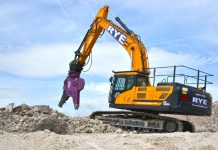Ben Griffiths, SHE and Operations Director, Rye Group, states that the demolition industry has a responsibility to reduce its environmental impact and contribute to a greener world
Every industry now faces a moral imperative to reduce its environmental impacts as much as possible. On the eve of COP26, the UK’s chief scientific advisor, Sir Patrick Vallance, noted that every little change we make as individuals can make a difference – and, as an industry, the world of construction and demolition can do more than a little.
Such action is absolutely necessary since climate-related disasters are now more frequent and devastating than ever, with the UN calling for “urgent priority action” in order to avert “lethal” impacts on the current and forthcoming generations.
This new layer of visibility to the issue brings with it a higher level of scrutiny towards any industries whose practices are not suitably sustainable.
Given the nature of the construction/demolition industry, we have a responsibility to stand at the forefront of the next wave of environmental mitigation, taking steps – whether small or drastic – to reduce our environmental impacts and contribute to a greener world.
Fortunately, there are an array of achievable possibilities for achieving this goal.
Limiting fuel usage
Carbon emissions are, beyond question, one of the most persistent and damaging side-effects of construction and demolition alike.
A recent survey from the British Business Bank has found that even smaller businesses contribute 30% of the UK’s current carbon emissions. As such, addressing this issue should be an exceptionally high priority.
Though this is an urgent matter, that doesn’t mean it has to be an especially difficult one to manage. Reducing fuel usage can take the straightforward form of reducing vehicle idling times: a minor habit that, incrementally, can culminate into a substantial reduction.
Other measures that might involve a little more planning include minimising travel distances to reduce fuel expenditure.
Embracing alternative fuels
There is, of course, more than one way to tackle the question of fuel emissions – and to some companies, the better course is simply to stop using fuel that emits carbon in the first place.
Hydro-treated vegetable oil (HVO), for example, reduces carbon emissions by around 90%, which represents an enormously green alternative to diesel.
And it may be surprising to learn that this switch need not be much more difficult than reducing vehicle idling, since HVO is entirely compatible with current diesel engines.
This means that construction and demolition companies can reduce their emissions substantially without needing to make any changes to their machinery or infrastructure – and, with red diesel soon to be taxed on par with alternative fuels, this is an excellent time to consider making the switch.
Noise pollution
Emissions aren’t the only way in which our machines can damage the environment, of course. In the demolition and construction industry, our equipment can – understandably – get loud.
This kind of noise pollution can be distressing for humans and animals alike, thereby contributing to a broader kind of environmental damage that disrupts ecosystems while contributing to a range of psychological, cardiac, and hearing-based issues in humans.
It’s possible to proactively combat this side-effect of our work through investment in more advanced, more efficient machines that simply produce less noise.
Dust
There are more tangible pollutants than noise that typify the work of our industry. In construction and – perhaps more prominently – in demolition, dust can act as a serious pollutant, contaminating natural spaces and potentially giving rise to health issues.
Moreover, according to the Institution for Environmental Sciences, such dust can both damage plants and even affect the diversity of ecosystems.
Though dust might seem an inevitable corollary to our work, there are steps we can take to control and suppress it.
We typically adopt targeted water-based dust suppression systems for demolition projects, in which the structure is kept wet before, during, and after the demolition process.
In addition, demolition contractors typically employ barriers around the demolition site, blocking dust and similar particulates to ensure the safety of the surrounding area.
Reuse and recycling
Demolition is about destroying structures – but that doesn’t mean it has to be about creating waste. Many of the materials used during construction – and, by extension, taken down during demolition – are perfectly recyclable.
This principle doesn’t just apply to obvious examples like wood, which can be reused in other constructions or burnt for fuel, but also items like insulation, metal, and aggregates (which usually take the form of loose rocks).
Even bricks and concrete can be reused – in fact, through a process of crushing, these materials can be turned into a form of aggregate themselves.
In fact, a 2021 government report has found that in 2018, the UK was able to recover 92.3% of construction and demolition waste – a testament to the potential our industry has for making comparably substantial changes to the other issues mentioned above.
Conclusion
Many of these solutions are, as our recycling progress attests, within the grasp of today’s construction and demolition companies. Moreover, such solutions can, in many respects, make life easier for firms in addition to reducing environmental impacts.
Recycling, for example, can potentially result in minimising the purchase or import of new materials, while reductions in fuel usage can have a positive financial impact on companies that adopt such changes.
But even when the situation isn’t a win-win, it’s beyond time for the industry to meaningfully play its part in mitigating the serious environmental challenges facing the planet today.




![[VIDEO] Behind-the-scenes video of M25 orbital bridge demolition released Tru7 Group has released footage of the M25 orbital bridge demolition, which reopened eight hours ahead of schedule](https://www.pbctoday.co.uk/news/wp-content/uploads/2024/03/image-from-tru7-video-218x150.png)





![[VIDEO]: HS2 contractors carry out M42 bridge demolition in timelapse footage of 52 hours Solihull-based firm Armac removed a 4,000 tonne bridge over the M42- and carried out the demolition ahead of schedule](https://www.pbctoday.co.uk/news/wp-content/uploads/2024/02/HS2-contractor-Armac-demolishes-M42-bridge-2_cropped-218x150.jpg)





